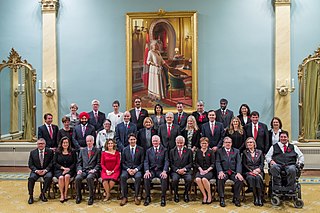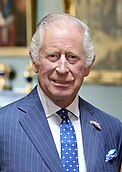The politics of Canada functions within a framework of parliamentary democracy and a federal system of parliamentary government with strong democratic traditions. Canada is a constitutional monarchy where the monarch is the ceremonial head of state. In practice, executive authority is entrusted to the Cabinet, a committee of ministers of the Crown chaired by the prime minister of Canada that act as the executive committee of the King's Privy Council for Canada and are responsible to the democratically elected House of Commons.

The prime minister of Canada is the head of government of Canada. Under the Westminster system, the prime minister governs with the confidence of a majority of the elected House of Commons; as such, the prime minister typically sits as a member of Parliament (MP) and leads the largest party or a coalition of parties. As first minister, the prime minister selects ministers to form the Cabinet.

The governor general of Canada is the federal representative of the Canadian monarch, currently King Charles III. The king or queen of Canada is also monarch and head of state of 14 other Commonwealth realms and lives in the United Kingdom. The monarch, on the advice of his or her Canadian prime minister, appoints a governor general to administer the government of Canada in the monarch's name. The commission is for an indefinite period—known as serving at His Majesty's pleasure—though, five years is the usual length of term. Since 1959, it has also been traditional to alternate between francophone and anglophone officeholders. The 30th and current governor general is Mary Simon, who was sworn in on 26 July 2021. An Inuk leader from Nunavik in Quebec, Simon is the first aboriginal person to hold the office.

The monarchy of Canada is Canada's form of government embodied by the Canadian sovereign and head of state. It is one of the key components of Canadian sovereignty and sits at the core of Canada's constitutional federal structure and Westminster-style parliamentary democracy. The monarchy is the foundation of the executive (King-in-Council), legislative (King-in-Parliament), and judicial (King-on-the-Bench) branches of both federal and provincial jurisdictions. The current monarch is King Charles III, who has reigned since 8 September 2022.

The Cabinet of Canada is a body of ministers of the Crown that, along with the Canadian monarch, and within the tenets of the Westminster system, forms the government of Canada. Chaired by the prime minister, the Cabinet is a committee of the King's Privy Council for Canada and the senior echelon of the Ministry, the membership of the Cabinet and Ministry often being co-terminal; as of November 2015 there were no members of the latter who were not also members of the former.
The style and title of the Canadian sovereign is the formal mode of address of the monarch of Canada. The form is based on those that were inherited from the United Kingdom and France, used in the colonies to refer to the reigning monarch in Europe. As various Canadian territories changed ownership and then the country gradually gained independence, the style and title of the monarchs changed almost as often as the kings and queens themselves. The mode of address currently employed is a combination of a style that originates in the early 17th century and a title established by Canadian law in 2024.

The King's Privy Council for Canada, sometimes called His Majesty's Privy Council for Canada or simply the Privy Council (PC), is the full group of personal consultants to the monarch of Canada on state and constitutional affairs. Practically, the tenets of responsible government require the sovereign or his viceroy, the governor general of Canada, to almost always follow only that advice tendered by the Cabinet: a committee within the Privy Council composed usually of elected members of Parliament. Those summoned to the KPC are appointed for life by the governor general on the advice of the prime minister of Canada, meaning that the group is composed predominantly of former Cabinet ministers, with some others having been inducted as an honorary gesture. Those in the council are accorded the use of an honorific style and post-nominal letters, as well as various signifiers of precedence.

The Government of Alberta is the body responsible for the administration of the Canadian province of Alberta. In modern Canadian use, the term Government of Alberta refers specifically to the executive—political ministers of the Crown who are appointed on the advice of the premier. Ministers direct the non-partisan civil service, who staff ministries and agencies to deliver government policies, programs, and services. The executive corporately brands itself as the Government of Alberta, or more formally, His Majesty's Government of Alberta.

The Government of Ontario is the body responsible for the administration of the Canadian province of Ontario. The term Government of Ontario refers specifically to the executive—political ministers of the Crown, appointed on the advice of the premier, and the non-partisan Ontario Public Service, who staff ministries and agencies to deliver government policies, programs, and services—which corporately brands itself as the Government of Ontario, or more formally, His Majesty's Government of Ontario.

In Canada, a lieutenant governor is the representative of the king of Canada in the government of each province. The governor general of Canada appoints the lieutenant governors on the advice of the prime minister of Canada to carry out most of the monarch's constitutional and ceremonial duties for an unfixed period of time—known as serving "His Excellency’s pleasure"—though five years is the normal convention. Similar positions in Canada's three territories are termed "commissioners" and are representatives of the federal government, not the monarch directly.

By the arrangements of the Canadian federation, Canada's monarchy operates in British Columbia as the core of the province's Westminster-style parliamentary democracy. As such, the Crown within British Columbia's jurisdiction is referred to as the Crown in Right of British Columbia, His Majesty in Right of British Columbia, or the King in Right of British Columbia. The Constitution Act, 1867, however, leaves many royal duties in British Columbia specifically assigned to the sovereign's viceroy, the Lieutenant Governor of British Columbia, whose direct participation in governance is limited by the conventional stipulations of constitutional monarchy.

By the arrangements of the Canadian federation, Canada's monarchy operates in Manitoba as the core of the province's Westminster-style parliamentary democracy. As such, the Crown within Manitoba's jurisdiction is referred to as the Crown in Right of Manitoba, His Majesty in Right of Manitoba, or the King in Right of Manitoba. The Constitution Act, 1867, however, leaves many royal duties in Manitoba specifically assigned to the sovereign's viceroy, the lieutenant governor of Manitoba, whose direct participation in governance is limited by the conventional stipulations of constitutional monarchy.

The monarchy of Canada forms the core of each Canadian provincial jurisdiction's Westminster-style parliamentary democracy, being the foundation of the executive, legislative, and judicial branches of government in each province. The monarchy has been headed since September 8, 2022 by King Charles III who as sovereign is shared equally with both the Commonwealth realms and the Canadian federal entity. He, his consort, and other members of the Canadian royal family undertake various public and private functions across the country. He is the only member of the royal family with any constitutional role.
The politics of Nova Scotia take place within the framework of a Westminster-style parliamentary constitutional monarchy. As Canada's head of state and monarch, Charles III is the sovereign of the province in his capacity as King in Right of Nova Scotia; his duties in Nova Scotia are carried out by the Lieutenant Governor, Michael Savage. The General Assembly is the legislature, consisting of the Lieutenant Governor and fifty-five members representing their electoral districts in the House of Assembly. The Government is headed by the Premier, Tim Houston, who took office on August 31, 2021. The capital city is Halifax, home to the Lieutenant Governor, the House of Assembly, and the Government. The House of Assembly has met in Halifax at Province House since 1819.
The Government of British Columbia is the body responsible for the administration of the Canadian province of British Columbia. The term Government of British Columbia can refer to either the collective set of all three institutions, or more specifically to the executive—ministers of the Crown of the day, and the non-political staff within each provincial department or agency, i.e. the civil services, whom the ministers direct—which corporately brands itself as the Government of British Columbia, or more formally, His Majesty's Government.
The Government of Quebec also known as His Majesty's Government for Quebec is the body responsible for the administration of the Canadian province of Quebec. The term Government of Quebec is typically used to refer to the executive—ministers of the Crown of the day, and the non-political staff within each provincial department or agency, i.e. the civil services, whom the ministers direct—which corporately brands itself as the Gouvernement du Québec, or more formally, His Majesty's Government.
The Canadian secretary to the King is the senior operational member of the royal household for the monarch of Canada, presently King Charles III. The office was established as Canadian secretary to the Queen in 1959. The present office holder is Donald Booth, who was appointed to the position in 2019.
The royal prerogative is a body of customary authority, privilege, and immunity recognized in common law as belonging to the sovereign, and which have become widely vested in the government. It is the means by which some of the executive powers of government, possessed by and vested in a monarch with regard to the process of governance of the state, are carried out.
The Letters Patent, 1947, are letters patent signed by George VI, as King of Canada, on 8 September 1947 and came into effect on 1 October of the same year. These letters, replacing the previous letters patent issued in 1931, reconstituted the Office of the governor general of Canada under the terms of the Constitution Act, 1867, expanding the governor general's ability to exercise the royal prerogative, thereby allowing her or him to use most of the "powers and authorities" lawfully belonging to the sovereign and to carry out an increased number of the sovereign's duties in "exceptional circumstances".














